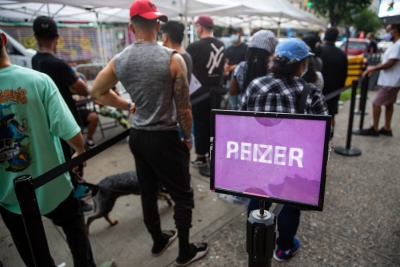SAINT-HERBLAIN, France & NEW YORK– Valneva SE (Nasdaq: VALN; Euronext Paris: VLA), a specialty vaccine company, and Pfizer Inc. (NYSE: PFE) today reported positive Phase 2 pediatric data for their Lyme disease vaccine candidate, VLA15. Based on these new results, Valneva and Pfizer plan to proceed with inclusion of pediatric participants in their planned Phase 3 trial. The trial will evaluate VLA15 in adults and pediatric subjects 5 years of age and above and is expected to be initiated in the third quarter of 2022, subject to regulatory approval.
The Phase 2 trial, VLA15-221, is the first clinical study with VLA15 which enrolled a pediatric population (5-17 years old). It compared the immunogenicity and safety of VLA15 after administration of two (at months 0 and 6) or three (at months 0, 2 and 6) primary series doses in groups aged 5-11, 12-17 and 18-65 years. In pediatric participants (5-17 years old) who received VLA15 in either the two-dose schedule (N=93) or three-dose schedule (N=97), VLA15 was found to be more immunogenic than in adults with both vaccination schedules tested. These data build on the strong immunogenicity profile already reported for adult participants (18-65 years old) in February 20221. Like in adults, the immunogenicity and safety data support a three-dose primary vaccination schedule in pediatric participants in the Phase 3 study.
The safety and tolerability profile observed in the 5- to 17-year age group was similar to the previously reported profile in adult participants. No vaccine-related serious adverse events (SAEs) were observed.
Valneva and Pfizer plan to submit these data for publication and presentation at a future scientific congress.
Juan Carlos Jaramillo M.D., Chief Medical Officer of Valneva, said, “Lyme disease affects all age groups, but with their affinity for being active outdoors, the pediatric population is at the greatest risk of Lyme disease. These first pediatric results are therefore extremely important and support the inclusion of pediatric participants in our planned Phase 3 trial. In partnership with Pfizer, we are excited to further investigate our VLA15 vaccine candidate, which will hopefully help protect both adults and children against Lyme disease.”
Kathrin U. Jansen, Ph.D., Senior Vice President and Head of Vaccine Research & Development at Pfizer, said: “The medical need for vaccination against Lyme disease is steadily increasing as the geographic footprint of the disease widens. These positive pediatric data mark an important step forward in the ongoing development of VLA15, and we are excited to continue working with Valneva to potentially help protect both adults and children from Lyme disease.”
VLA15 is the only Lyme disease vaccine candidate currently in clinical development. This investigational multivalent protein subunit vaccine uses an established mechanism of action for a Lyme disease vaccine that targets the outer surface protein A (OspA) of Borrelia burgdorferi, the bacteria that cause Lyme disease. OspA is one of the most dominant surface proteins expressed by the bacteria when present in a tick. Blocking OspA inhibits the bacterium’s ability to leave the tick and infect humans. The vaccine covers the six most common OspA serotypes expressed by Borrelia burgdorferi sensu lato species that are prevalent in North America and Europe. VLA15 has demonstrated a strong immunogenicity and safety profile in pre-clinical and clinical studies so far. The program was granted Fast Track designation by the U.S. Food and Drug Administration (FDA) in July 20172. Valneva and Pfizer entered into a collaboration agreement in April 2020 to co-develop VLA153.
VLA15-221 is a randomized, observer-blind, placebo-controlled Phase 2 study. It is the first clinical study with VLA15 which enrolled a pediatric population (5-17 years old).
585 healthy participants received VLA15 at two different immunization schedules (month 0-2-6 [N=190] or month 0-6 [N=187]) or three doses of placebo (month 0-2-6 [N=208]). Vaccine recipients received VLA15 at a dose of 180 µg, which was selected based on data generated in the two previous Phase 2 studies. The main safety and immunogenicity readout was performed one month after the primary vaccination series. A subset of participants will receive a booster dose of VLA15 or placebo at month 18 (booster phase) and will be followed for three additional years to monitor antibody persistence.
VLA15 is tested as an alum-adjuvanted formulation and administered intramuscularly. The study is being conducted at U.S. sites located in areas where Lyme disease is endemic and has enrolled both volunteers with a cleared past infection with Borrelia burgdorferi as well as Borrelia burgdorferi-naïve volunteers.
Lyme disease is a systemic infection caused by Borrelia burgdorferi bacteria transmitted to humans by infected Ixodes ticks4. It is considered the most common vector-borne illness in the Northern Hemisphere. While the true incidence of Lyme disease is unknown, it is estimated to annually affect approximately 476,000 people in the United States5 and 130,000 people in Europe6. Early symptoms of Lyme disease (such as a gradually expanding erythematous rash called Erythema migrans or more unspecific symptoms like fatigue, fever, headache, mild stiff neck, arthralgia or myalgia) are often overlooked or misinterpreted. Left untreated, the disease can disseminate and cause more serious complications affecting the joints (arthritis), the heart (carditis) or the nervous system. The medical need for vaccination against Lyme disease is steadily increasing as the geographic footprint of the disease widens7.
References
1 Valneva and Pfizer Report Further Positive Phase 2 Data for Lyme Disease Vaccine Candidate – Valneva
2 Valneva Receives FDA Fast Track Designation for its Lyme Disease Vaccine Candidate VLA15
3 Valneva and Pfizer Announce Collaboration to Co-Develop and Commercialize Lyme Disease Vaccine, VLA15
4 Stanek et al. 2012, The Lancet 379:461–473
5 Source: https://www.cdc.gov/lyme/stats/humancases.html
6 Sykes RA, et al. An estimate of Lyme borreliosis incidence in Western Europe. Journal of Public Health 2017; 39(1): 74-81
7 New Scientist, Lyme disease is set to explode and we still don’t have a vaccine; March 29, 2017. https://www.newscientist.com/article/mg23431195-800-lyme-disease-is-set-to-explode-and-you-cant-protect-yourself/


